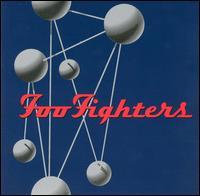In 1997, Foo Fighters released what would become one of the most significant albums of the late nineties. Following what was essentially a solo album by the ex-Nirvana drummer, Dave Grohl enlisted the help of former band mate/ex-Germs Pat Smear on guitar, Sunny Day Real Estate’s Nate Mendel on bass, and to a much lesser extent SDRE’s drummer William Goldsmith. Also on board was producer Gil Norton who would give the band their slick sound. Grohl remained the visionary but Foo Fighters greatly benefitted from the experience of these talented players. While The Colour and the Shape is easily the band’s most cohesive album, it also went on to represent what Foo Fighters would become: an arena rock band remembered for its consistent output of singles.
Every aspect of The Colour and the Shape was better than its predecessor. Foo Fighters compiled a group of songs Grohl had been working on for indeterminate amounts of time. The Colour and the Shape was structured, well thought out. A true breakup album, Grohl’s divorce loomed heavily over the recording, which allowed him to get more personal. From opener “Doll” through “Walking After You,” the journey ebbed and flowed like a single relationship, filtering emotions through loud/soft dynamics.
There was plenty to mine from The Colour and the Shape like “Hey, Johnny Park!” or “My Poor Brain." But in terms of its legacy, there were three songs that mattered: “Monkey Wrench,” “My Hero,” and the mother of all sing-alongs “Everlong.” “Monkey Wrench” was a true rocker, layered with multiple memorable riffs and a giant hook. If that wasn’t enough, Grohl’s final vocal rant exorcised his demons, he and his ex finally free. “My Hero,” the third single, was a constant source of curiosity. While Grohl claimed the song was about personal “everyday” heroes, many suspected it was a tribute to Kurt Cobain. Either way, “My Hero” proved to be a powerhouse tribute with the drums alone justifying the firing on Goldsmith. No one topped Grohl when it came to arena rock drumming, and here he reminded everyone. Plus, of course, another soaring Dave Grohl chorus. But even in a pantheon of giant alternative hits, nothing compared to “Everlong,” one of the greatest rock songs of the 1990’s, possibly ever. The song was about falling in love with Louise Post of Veruca Salt on the heels of his messy divorce, but it transcended the specificity of the situation. Everything about “Everlong” stuck. The guitar, the drum build up to the final chorus, the inherent instinct to to yell, “If everything could ever feel this real forever!” whenever it played. “Everlong” elevated Foo Fighters to festival headliners. It was the moment they became rock stars.
The Colour and the Shape molded the Foos career thereafter. On each subsequent album, there existed a hierarchy of hits, filler, and sometimes trash. The Colour and the Shape had no filler, just bigger hits. And the only trash was “New Way Home” due to its unnecessary tacked-on vibe. The album also established the aforementioned loud/soft dynamic that would inject itself into most of their biggest hits and bog down some of their later records.
There’s always a big deal made about how this was Grohl’s first record outside the shadow of Nirvana, but that does The Colour and the Shape a disservice. Grohl and co. wrote an incredible, lasting piece of music that has withstood the test of time, never feeling like a “90’s record.” Foo Fighters have made good albums since The Colour and the Shape but none as good. This is an essential album, not just in Foo Fighters' discography but for any true rock and roll fan.
